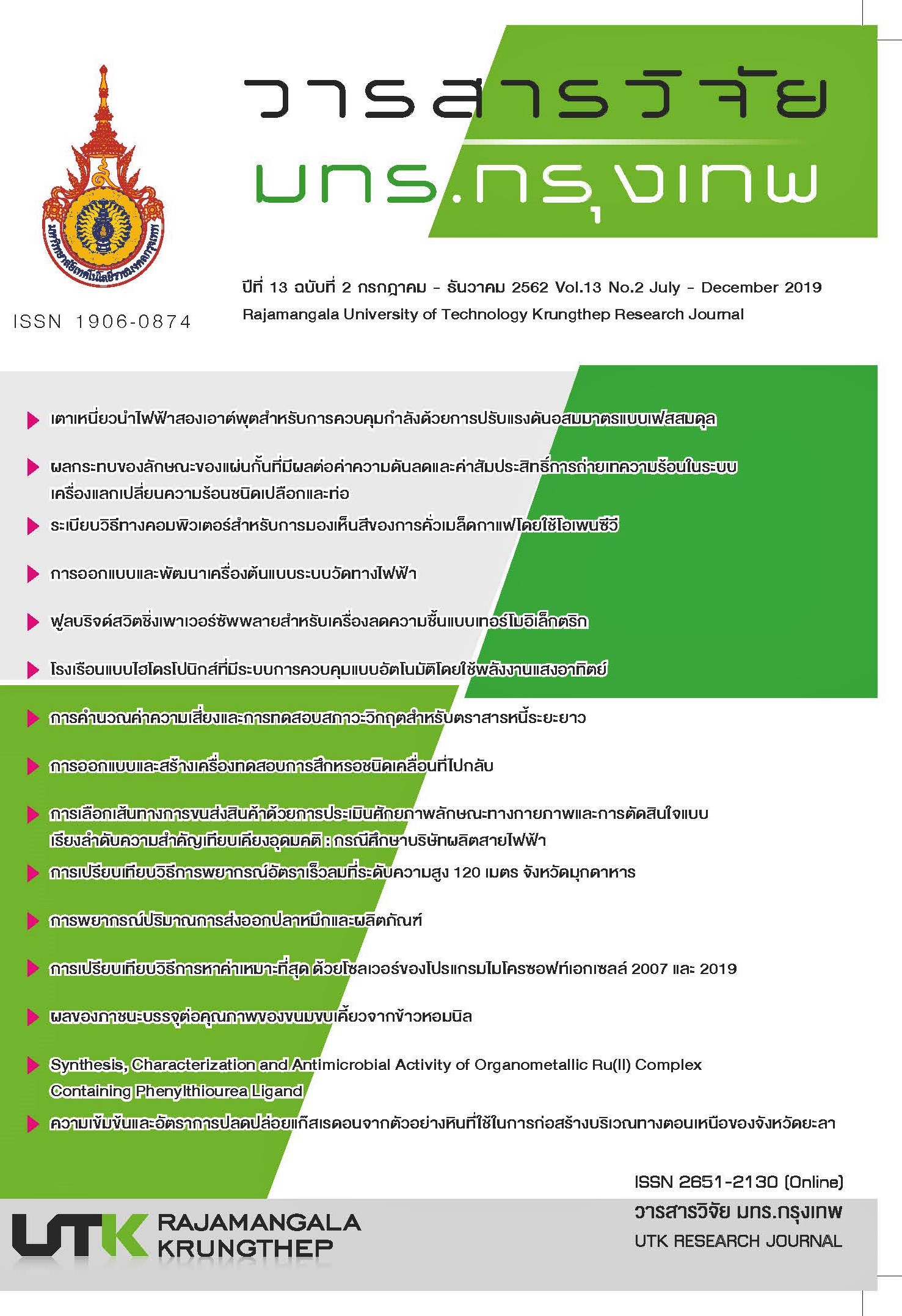การเลือกเส้นทางการขนส่งสินค้าด้วยการประเมินศักยภาพลักษณะทางกายภาพและการตัดสินใจแบบเรียงลำดับความสำคัญเทียบเคียงอุดมคติ: กรณีศึกษาบริษัทผลิตสายไฟฟ้า
คำสำคัญ:
การตัดสินใจแบบเรียงลำดับความสำคัญเทียบเคียงอุดมคติ, การเลือกเส้นทางขนส่งสินค้า, การประเมินศักยภาพ, ลักษณะทางกายภาพบทคัดย่อ
การศึกษาวิจัยครั้งนี้มีวัตถุประสงค์เพื่อเสนอวิธีการตัดสินใจเลือกเส้นทางการขนส่งสินค้าทางถนนด้วยการตัดสินใจแบบเรียงลำดับความสำคัญจากการเทียบเคียงทางอุดมคติ โดยพิจารณาเกณฑ์การตัดสินใจ ได้แก่ ต้นทุนค่าขนส่ง ระยะเวลาการขนส่ง และระดับศักยภาพลักษณะทางกายภาพของแต่ละเส้นทางการขนส่งสินค้า พร้อมทั้งประยุกต์วิธีการที่เสนอกับกรณีศึกษาบริษัทผลิตสายไฟฟ้า ผลการศึกษาวิจัยพบว่าเส้นทางการขนส่งสินค้าทางถนน A2 และ A3 เป็นเส้นทางการขนส่งสินค้าทางถนนที่เหมาะสมมากที่สุดด้วยค่าความสัมพันธ์เข้าใกล้แนวคิดวิธีแก้ปัญหาเท่ากับ 0.550 และ 0.551 ซึ่งไม่แตกต่างกันอย่างมีนัยสำคัญ เส้นทางการขนส่งสินค้าทางถนน A1 เป็นทางเลือกที่มีความเหมาะสมลำดับที่สอง และเส้นทางการขนส่งสินค้าทางถนน A4 เป็นทางเลือกลำดับสุดท้าย นอกจากนี้วิธีการเลือกเส้นทางการขนส่งสินค้าที่เสนอซึ่งเป็นการตัดใจแบบเชิงรุกสามารถนำไปใช้แก้ปัญหาได้จริง อีกทั้งยังหลีกเลี่ยงการตัดสินใจเชิงอัตวิสัยและตอบสนองต่อความต้องการผู้ตัดสินใจได้อย่าง
มีประสิทธิภาพโดยการกำหนดน้ำหนักความสำคัญให้กับเกณฑ์การตัดสินใจ
เอกสารอ้างอิง
[2] Farah H, Polus A, Cohen MA. Development of an infrastructure coefficient by an analytic hierarchy process and its relationship to safety. IATSS Res. 2007; 31(1):120-32.
[3] Handerson M. Human factors in traffic safety: a reappraisal. 1st ed. New South Wales: Traffic Accident Research Unit, Department of Motor Transport; 1971.
[4] Kopytov E, Abramov D. Multiple-criteria analysis and choice of transportation alternatives in multimodal freight transport system. Transp Telecommun. 2012; 13(2):148-58.
[5] Kengpol A, Meethom W, Tuominen M. The development of a decision support system in multimodal transportation routing within Greater Mekong sub-region countries. Int J Prod Econ. 2012; 140(2):691-701.
[6] Kengpol A, Tuammee S. The development of a decision support framework for a quantitative risk assessment in multimodal green logistics: an empirical study. Int J Prod Res. 2016; 54(4):1020-38.
[7] Kengpol A, Tuammee S, Tuominen M. The development of a framework for route selection in multimodal transportation. Int J Logist Manag. 2014; 25(3):581-610.
[8] Arunyanart S, Ohmori S, Yoshimoto K. Selection of export route option in GMS region: recommendation for current situation. J Jpn Ind Manage Assoc. 2016; 67(2E):193-201.
[9] Sattayaprasert W, Taneerananon P, Hanaoka S, et al. Creating a risk-based network for HazMat logistics by route prioritization with AHP. IATSS Res. 2008; 32(1):74-87.
[10] Yuan L, Yuan H, Ma Y, et al. Development of a safety evaluation model for provincial highway. Discret Dyn Nat Soc. 2014; 2014(1):1-10.
[11] นิธิเดช คูหาทองสัมฤทธิ์. การเลือกเส้นทางการขนส่งสินค้าที่เหมาะสม โดยตัวแบบโปรแกรมเป้าหมายแบบศูนย์หนึ่ง. วารสาร
วิจัยราชภัฏพระนคร สาขาวิทยาศาสตร์และเทคโนโลยี. 2560; 12(2):78-91.
[12] Hwang CL, Yoon K. Multiple attribute decision making: methods and applications. 1st ed. New York: Springer-Verlag; 1981.
[13] วรพจน์ มีถม. เกณฑ์การประเมินศักยภาพเส้นทางการขนส่งสินค้าทางถนน. วารสารบริหารธุรกิจเทคโนโลยีมหานคร. 2556; 10(2):61-80.
[14] Kaewfak K, Ammarapala V. The decision making of freight route in multimodal transportation. Suranaree J Sci Technol. 2018; 25(1):1-10.
[15] Liu S, Wang J, Fu T. Effects of lane width, lane position and edge shoulder width on driving behavior in under-ground urban expressways: a driving simulator study. Int J Environ Res Public Health. 2016; 13(10):1-14.
[16] Meethom W, Koohathongsumrit N. Design of decision support system for road freight transportation routing using Multilayer Zero One Goal Pro-gramming. Eng j. 2018; 22(6):185-205.
[17] นิธิเดช คูหาทองสัมฤทธิ์. การเลือกเส้นทางการขนส่งวัตถุดิบที่เหมาะสม กรณีศึกษาโรงงานผลิตอาหารสำเร็จรูป. วารสารวิจัยรามคำแหง (วิทยาศาสตร์และเทคโนโลยี). 2560; 20(1):1-17.
[18] Du J, Jiang Y, Wang K, et al. Evaluation of pilotage dispatching operation for Dalian Port in China based on FCE–AHP method. J Int Marit Saf Environ Aff Shipping. 2017; 1(1):11-8.
[19] Saaty TL. How to make a decision: the analytic hierarchy process. Eur J Oper Res. 1990; 48(1):9-26.
[20] Day J, Bobeva M. A generic toolkit for the successful management of Delphi studies. Elect J Bus Res Meth. 2005; 3(2):103-16.
[21] Barzekar G, Aziz A, Mariapan M, et al. Delphi technique for generating criteria and indicators in monitoring ecotourism sustainability in Northern forests of Iran: case study on Dohezar and Sehezar Watersheds. Folia For Pol Ser A. 2011; 53(2):130-41.
[22] Latif Ra, Dahlan A, Mulud ZA, et al. The Delphi technique as a method to obtain consensus in health care education research. Educ Med J. 2017; 9(3):89-102.
[23] Mangla SK, Kumar P, Barua MK. Risk analysis in green supply chain using fuzzy AHP approach: a case study. Resour Conserv Recycl. 2015; 104(12B):375-90.
[24] นิธิเดช คูหาทองสัมฤทธิ์. การคัดเลือกผู้ให้บริการโลจิสติกส์ที่เหมาะสมด้วยกระบวนการลำดับขั้นเชิงวิเคราะห์แบบฟัซซี กรณีศึกษาโรงงานผลิตผลิตภัณฑ์ยาง. วารสารวิชาการ มทร. สุวรรณภูมิ. 2561; 6(2):182-93.
[25] Saaty TL. The analytic hierarchy process. 1st ed. New York: McGraw-Hill; 1980.
[26] Kaynak S, Altuntas S, Dereli T. Comparing the innovation performance of EU candidate countries: an entropy-based TOPSIS approach. Econ Res-Ekon Istraz. 2017; 30(1):31-54.
[27] Aminbakhsh S, Gunduz M, Sonmez R. Safety risk assessment using analytic hierarchy process (AHP) during planning and budgeting of construction projects. J Safety Res. 2013; 46(3):99-105.
[28] Araujo CAS, Wanke P, Siqueira MM. A performance analysis of Brazilian public health: TOPSIS and neural networks application. Int J Prod Perform Manag. 2018; 67(9):1526-49.
[29] Yuvaraj N, Kumar PD. Multiresponse optimization of abrasive water jet cutting process parameters using TOPSIS approach. Mater Manuf Process. 2015; 30(5):882-9.
[30] Nyimbili PH, Erden T, Karaman H. Integration of GIS, AHP and TOPSIS for earthquake hazard analysis. Nat Hazards. 2018; 92(3):1523-46.
[31] Zyoud SH, Funch-Hanusch D. biblio-metric-based survey on AHP and TOPSIS techniques. Expert Syst Appl. 2017; 78(15):287-303.
[32] Sarkar A. A TOPSIS method to evaluate the technologies. Int J Qual Reliab Manag. 2013; 31(1):2-13.
[33] Karahalios H. The application of the AHP-TOPSIS for evaluating ballast water treatment systems by ship operators. Transp Res Part D Transp Environ. 2017; 52(3A):172-84.
ดาวน์โหลด
เผยแพร่แล้ว
รูปแบบการอ้างอิง
ฉบับ
ประเภทบทความ
สัญญาอนุญาต
กองบรรณาธิการวารสารวิชาการ มหาวิทยาลัยเทคโนโลยีราชมงคลกรุงเทพ มีความยินดีที่จะรับบทความจากอาจารย์ นักวิจัย นักวิชาการทั้งภายในและภายนอกมหาวิทยาลัย ในสาขาวิชาวิทยาศาสตร์และเทคโนโลยี ได้แก่ สาขาวิชาวิทยาศาสตร์ วิศวกรรมศาสตร์ และสาขาอื่นๆ ที่เกี่ยวข้อง รวมถึงสาขาต่างๆ ที่มีการบูรณาการข้ามศาสตร์ที่เกี่ยวข้องวิทยาศาสตร์และเทคโนโลยี ที่เขียนเป็นภาษาไทยหรือภาษาอังกฤษ ซึ่งผลงานวิชาการที่ส่งมาขอตีพิมพ์ต้องไม่เคยเผยแพร่ในสิ่งพิมพ์อื่นใดมาก่อน และต้องไม่อยู่ในระหว่างการพิจารณาของวารสารอื่น
การละเมิดลิขสิทธิ์ถือเป็นความรับผิดชอบของผู้ส่งบทความโดยตรง บทความที่ได้รับการตีพิมพ์ต้องผ่านการพิจารณากลั่นกรองคุณภาพจากผู้ทรงคุณวุฒิและได้รับความเห็นชอบจากกองบรรณาธิการ
ข้อความที่ปรากฏอยู่ในแต่ละบทความที่ตีพิมพ์ในวารสารวิชาการเล่มนี้ เป็นความคิดเห็นส่วนตัวของผู้เขียนแต่ละท่าน ไม่เกี่ยวข้องกับมหาวิทยาลัยเทคโนโลยีราชมงคลกรุงเทพแต่อย่างใด ความรับผิดชอบด้านเนื้อหาและการตรวจร่างบทความแต่ละบทความเป็นของผู้เขียนแต่ละท่าน หากมีความผิดพลาดใดๆ ผู้เขียนแต่ละท่านจะต้องรับผิดชอบบทความของตนเองแต่ผู้เดียว
กองบรรณาธิการขอสงวนสิทธิ์มิให้นำเนื้อหา หรือข้อคิดเห็นใดๆ ของบทความในวารสารวิชาการ มหาวิทยาลัยเทคโนโลยีราชมงคลกรุงเทพ ไปเผยแพร่ก่อนได้รับอนุญาตจากกองบรรณาธิการ อย่างเป็นลายลักษณ์อักษร ผลงานที่ได้รับการตีพิมพ์ถือเป็นลิขสิทธิ์ของวารสาร






